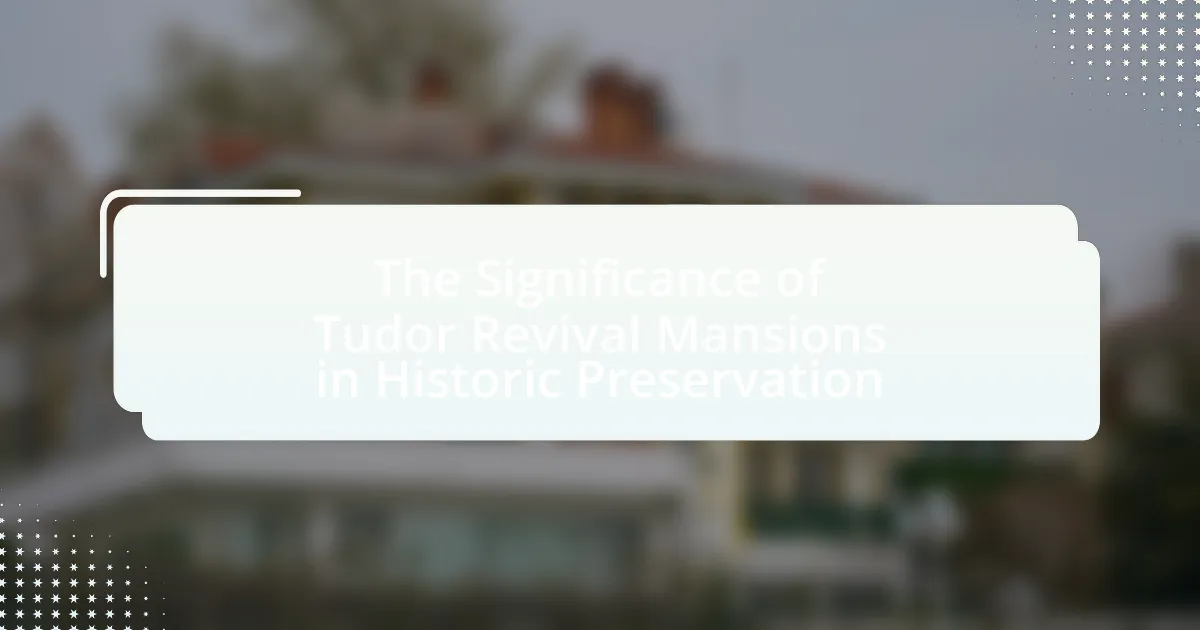Tudor Revival Mansions are significant architectural structures inspired by late medieval English design, characterized by steeply pitched roofs, decorative half-timbering, and tall, narrow windows. Emerging in the late 19th century, this style reflects a reaction against industrialization and a desire for authenticity in architecture, often associated with the Arts and Crafts movement. The article explores the historical context, key characteristics, and cultural significance of Tudor Revival Mansions, emphasizing their role in historic preservation and community identity. It also addresses the challenges these structures face, including urban development pressures and financial constraints, while highlighting best practices and resources for effective preservation efforts.

What are Tudor Revival Mansions and their Historical Context?
Tudor Revival Mansions are large residential structures inspired by the architectural styles of late medieval England, characterized by features such as steeply pitched roofs, decorative half-timbering, and tall, narrow windows. This architectural style emerged in the late 19th century and gained popularity in the early 20th century, particularly in the United States, as part of a broader movement that sought to evoke a sense of nostalgia for the past and a connection to English heritage. The Tudor Revival style was often associated with the Arts and Crafts movement, which emphasized craftsmanship and traditional building techniques. Its historical context includes a reaction against industrialization and a desire for a romanticized view of history, reflecting societal values of the time that favored authenticity and craftsmanship in architecture.
How did the Tudor Revival style emerge in architecture?
The Tudor Revival style emerged in architecture during the late 19th century as a reaction against the classical styles that dominated the period. This architectural movement was inspired by the medieval English architecture of the Tudor period, characterized by features such as steeply pitched gable roofs, decorative half-timbering, and tall, narrow windows. The style gained popularity in the United States and Britain, particularly through the Arts and Crafts movement, which emphasized craftsmanship and traditional building techniques. The 1890s saw a significant rise in Tudor Revival homes, as architects like Charles Voysey and Edwin Lutyens incorporated these elements into their designs, reflecting a growing interest in historical styles and a desire for a romanticized view of the past.
What are the key characteristics of Tudor Revival architecture?
Tudor Revival architecture is characterized by its steeply pitched gable roofs, decorative half-timbering, and tall, narrow windows with leaded glass. This style, which emerged in the late 19th century, draws inspiration from medieval English architecture, particularly the Tudor period. Key features include brick or stone exteriors, prominent chimneys, and asymmetrical facades, which contribute to a picturesque and romantic aesthetic. The use of rich materials and intricate detailing further enhances the architectural appeal, making Tudor Revival homes distinctive in the context of historic preservation.
How does Tudor Revival differ from other architectural styles?
Tudor Revival differs from other architectural styles primarily through its distinct use of half-timbering, steeply pitched gable roofs, and decorative brickwork. This style, which emerged in the late 19th and early 20th centuries, draws inspiration from medieval English architecture, characterized by its asymmetrical facades and prominent chimneys. Unlike Neoclassical or Modernist styles that emphasize symmetry and minimalism, Tudor Revival embraces a more eclectic and ornate aesthetic, often incorporating elements such as leaded glass windows and stone detailing. The historical context of Tudor Revival reflects a romanticized view of the past, contrasting with the functionalism seen in contemporary architectural movements.
Why are Tudor Revival Mansions significant in the context of historic preservation?
Tudor Revival Mansions are significant in the context of historic preservation because they represent a unique architectural style that reflects the cultural and historical values of the early 20th century. This style, characterized by steeply pitched gable roofs, decorative half-timbering, and intricate masonry, emerged in the United States during the 1890s and gained popularity through the 1940s. The preservation of these mansions helps maintain the architectural diversity of neighborhoods and serves as a tangible connection to the past, showcasing the craftsmanship and design trends of their era. Furthermore, Tudor Revival Mansions often embody the social history of the communities in which they are located, making their preservation vital for understanding local heritage and identity.
What role do these mansions play in representing cultural heritage?
Tudor Revival mansions serve as vital representations of cultural heritage by embodying the architectural styles and social values of their time. These structures reflect the historical context of the early 20th century, showcasing craftsmanship and design elements that are characteristic of the Tudor Revival movement, which sought to evoke a sense of nostalgia for medieval England. The preservation of these mansions contributes to the understanding of cultural identity and community history, as they often house significant artifacts and narratives that illustrate the lifestyle and aspirations of the era. For instance, the intricate woodwork, leaded glass windows, and steeply pitched roofs are not only aesthetic features but also signify the cultural influences and artistic trends that shaped American architecture during that period.
How do Tudor Revival Mansions contribute to community identity?
Tudor Revival Mansions contribute to community identity by serving as architectural landmarks that reflect the historical and cultural values of the area. These structures often embody a sense of nostalgia and continuity, linking residents to their local heritage. For instance, neighborhoods featuring Tudor Revival architecture frequently attract tourism and foster community pride, as they represent a unique aesthetic that distinguishes the area from others. Furthermore, the preservation of these mansions can enhance property values and promote local economic development, reinforcing the community’s identity as a place of historical significance.

What challenges do Tudor Revival Mansions face in preservation efforts?
Tudor Revival Mansions face significant challenges in preservation efforts primarily due to their unique architectural features and materials, which can be difficult to restore. The intricate half-timbering, leaded glass windows, and specific masonry techniques often require specialized skills and materials that are not readily available, leading to increased costs and complexity in restoration projects. Additionally, many Tudor Revival structures are located in urban areas where development pressures can threaten their existence, as property owners may prioritize modernization or redevelopment over preservation. Historical preservation regulations can also pose challenges, as navigating the legal requirements for maintaining historical integrity can be cumbersome and time-consuming.
What are the common threats to Tudor Revival Mansions?
Common threats to Tudor Revival Mansions include neglect, environmental damage, and inappropriate renovations. Neglect leads to deterioration of structural elements, while environmental factors such as moisture and pests can cause significant damage to wood and masonry. Inappropriate renovations often compromise the architectural integrity and historical value of these properties, as seen in cases where original materials are replaced with modern alternatives. According to the National Trust for Historic Preservation, maintaining the authenticity of Tudor Revival Mansions is crucial for preserving their historical significance.
How does urban development impact the preservation of these structures?
Urban development significantly impacts the preservation of Tudor Revival mansions by often prioritizing new construction over the conservation of historical structures. As cities expand, the demand for land can lead to the demolition or alteration of these mansions, which are vital to understanding architectural history and cultural heritage. For instance, a study by the National Trust for Historic Preservation indicates that urban areas with aggressive development policies frequently see a decline in the number of preserved historic buildings, with many Tudor Revival mansions facing threats from zoning changes and redevelopment projects. This trend underscores the need for effective preservation strategies to safeguard these structures amidst urban growth.
What are the financial challenges associated with maintaining Tudor Revival Mansions?
Maintaining Tudor Revival Mansions presents significant financial challenges primarily due to high restoration costs and ongoing maintenance expenses. The intricate architectural details, such as half-timbering and leaded glass windows, require specialized craftsmanship, which can be expensive. Additionally, these historic structures often need updates to meet modern building codes and energy efficiency standards, further increasing costs. For instance, a study by the National Trust for Historic Preservation indicates that restoration projects can exceed hundreds of thousands of dollars, depending on the mansion’s condition and historical significance. Furthermore, ongoing maintenance, including roof repairs and landscaping, can strain budgets, especially for owners of multiple properties or those relying on limited funding sources.
How can preservationists effectively advocate for Tudor Revival Mansions?
Preservationists can effectively advocate for Tudor Revival Mansions by emphasizing their architectural significance and historical value. Tudor Revival Mansions, characterized by their steeply pitched gable roofs, decorative half-timbering, and intricate masonry, represent a unique blend of medieval English styles and American craftsmanship, making them culturally important. Advocacy efforts can include organizing community awareness campaigns, collaborating with local historical societies, and leveraging social media to highlight the aesthetic and historical merits of these structures. For instance, studies show that neighborhoods with preserved historic homes often experience increased property values, which can be a compelling argument for preservation efforts. Engaging local government and seeking designation as historic landmarks can also provide legal protections and funding opportunities for restoration projects.
What strategies can be employed to raise awareness about their significance?
To raise awareness about the significance of Tudor Revival mansions in historic preservation, targeted educational campaigns can be employed. These campaigns can include workshops, lectures, and guided tours that highlight the architectural features and historical context of Tudor Revival mansions, emphasizing their cultural value. For instance, the National Trust for Historic Preservation often organizes events that showcase the importance of preserving such structures, demonstrating their role in community identity and heritage. Additionally, leveraging social media platforms to share stories, images, and facts about Tudor Revival mansions can engage a broader audience, as studies show that visual content significantly increases public interest in historical topics.
How can community involvement enhance preservation efforts?
Community involvement enhances preservation efforts by fostering local engagement and support for historical sites, such as Tudor Revival mansions. When community members actively participate in preservation initiatives, they contribute valuable insights, resources, and volunteer labor, which can lead to more effective and sustainable preservation outcomes. For instance, studies have shown that neighborhoods with strong community ties are more likely to successfully advocate for the protection of their historic landmarks, as evidenced by the preservation of Tudor Revival homes in various regions where local advocacy groups mobilized public interest and funding. This collective action not only raises awareness but also cultivates a sense of ownership and pride among residents, further solidifying their commitment to preserving their architectural heritage.

What are the best practices for preserving Tudor Revival Mansions?
The best practices for preserving Tudor Revival Mansions include maintaining original architectural features, using historically accurate materials for repairs, and implementing climate control measures to protect the structure. Preservationists emphasize the importance of documenting existing conditions and conducting regular maintenance to prevent deterioration. For instance, the National Park Service recommends using traditional craftsmanship techniques to restore woodwork and masonry, ensuring that any alterations respect the building’s historical integrity. Additionally, engaging with local preservation societies can provide valuable resources and support for ongoing preservation efforts.
What techniques are effective in restoring Tudor Revival architecture?
Effective techniques in restoring Tudor Revival architecture include careful material selection, historical research, and skilled craftsmanship. Material selection involves sourcing authentic or period-appropriate materials such as timber, brick, and stone to maintain the architectural integrity. Historical research is crucial for understanding the original design elements and construction methods, ensuring that restorations are accurate to the period. Skilled craftsmanship is necessary for replicating intricate details like half-timbering, leaded glass windows, and decorative masonry, which are hallmarks of Tudor Revival style. These techniques collectively preserve the aesthetic and historical significance of Tudor Revival mansions, contributing to their value in historic preservation efforts.
How can original materials be sourced for restoration projects?
Original materials for restoration projects can be sourced through a combination of salvage operations, specialized suppliers, and historical research. Salvage operations involve reclaiming materials from demolished or renovated buildings, ensuring authenticity and compatibility with the original structure. Specialized suppliers often provide reclaimed or reproduction materials that match historical specifications, such as wood, stone, and metal. Historical research is crucial for identifying the specific materials used in the original construction, which can guide sourcing efforts. For example, the National Park Service emphasizes the importance of using original materials to maintain the historical integrity of structures, highlighting that accurate sourcing contributes to the preservation of cultural heritage.
What role does historical accuracy play in restoration efforts?
Historical accuracy is crucial in restoration efforts as it ensures that the reconstructed elements reflect the original design, materials, and craftsmanship of the period. This adherence to historical accuracy preserves the cultural and architectural integrity of Tudor Revival mansions, which are significant in the context of historic preservation. For instance, using authentic materials and techniques not only honors the original builders’ intentions but also enhances the educational value of the restoration, allowing future generations to understand and appreciate the historical context. Studies have shown that restorations grounded in historical accuracy receive greater public support and recognition, reinforcing the importance of maintaining fidelity to the original structures.
What resources are available for those interested in Tudor Revival preservation?
Resources available for those interested in Tudor Revival preservation include specialized organizations, publications, and online platforms. The National Trust for Historic Preservation offers guidelines and resources specifically for Tudor Revival architecture, while the Society for the Preservation of New England Antiquities provides insights into preservation techniques. Additionally, books such as “The Tudor Revival: Style and Tradition” by David A. Hanks serve as valuable references. Online forums and social media groups dedicated to historic preservation also facilitate knowledge sharing among enthusiasts and professionals. These resources collectively support the preservation of Tudor Revival architecture by providing essential information and community engagement.
How can local organizations support preservation initiatives?
Local organizations can support preservation initiatives by actively engaging in advocacy, fundraising, and educational outreach. These organizations can advocate for policies that protect historic sites, such as Tudor Revival mansions, by collaborating with local governments and heritage groups. Fundraising efforts can be directed towards restoration projects, ensuring that necessary resources are available for maintaining these structures. Additionally, educational outreach programs can raise community awareness about the historical significance of Tudor Revival architecture, fostering public interest and support for preservation efforts. For instance, the National Trust for Historic Preservation emphasizes the importance of community involvement in preserving local heritage, demonstrating that grassroots efforts can lead to successful preservation outcomes.
What grants or funding opportunities exist for Tudor Revival projects?
Grants and funding opportunities for Tudor Revival projects include the Historic Preservation Fund, which provides federal funding for preservation efforts, and state-level grants available through various state historic preservation offices. Additionally, organizations like the National Trust for Historic Preservation offer grants specifically for the restoration of historic properties, including Tudor Revival structures. These funding sources are designed to support the preservation of significant architectural styles and promote heritage conservation.
What practical steps can individuals take to support Tudor Revival preservation?
Individuals can support Tudor Revival preservation by participating in local preservation organizations and advocating for the protection of historic sites. Engaging with community groups dedicated to preserving architectural heritage can lead to initiatives that raise awareness and funds for restoration projects. Additionally, individuals can volunteer for restoration efforts, attend workshops on preservation techniques, and promote the significance of Tudor Revival architecture through social media and local events. Supporting legislation that protects historic buildings is also crucial; for example, individuals can contact local representatives to express their support for preservation ordinances. These actions contribute to maintaining the cultural and historical integrity of Tudor Revival structures, which are significant for their unique architectural features and historical context.

Leave a Reply